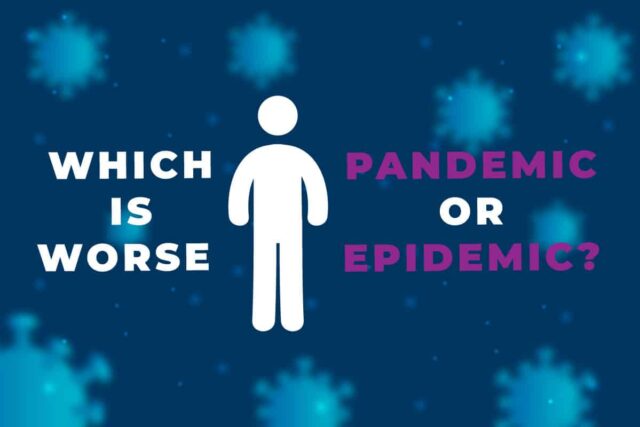Which is worse, pandemic or epidemic? Infectious diseases and illnesses have been with humanity for a long time. However, the rapid spread of these diseases began during the Agrarian revolution.
Humans got more civilized, and their interactions increased. Some of the diseases that first appeared during the Agrarian shift include:
- Tuberculosis
- Malaria
- Smallpox
- Influenza
A pandemic is the worst level of an infectious disease outbreak. But not all episodes become pandemics since they are controlled at the early stages.
The number of pandemics has risen over the past century. The increase is due to the increased exploitation of nature, urbanization, and integration due to global travel.
Despite the increase, there has been a reduction in the number of deaths due to healthcare improvements. There are planned mitigations that aid in controlling the pandemic.
Now, back to our question,
Which is worse, pandemic or epidemic? A pandemic is worse than an epidemic. The fact that pandemics affect a larger geographical area makes it savage. The death toll is higher than that of epidemics. A colossal death toll reduces the population. It affects the economy of an area leading to other indirect impacts.
Phases Of Pandemic
The development of the phases of the pandemic was in 1999. A revision in 2005 after delayed reporting of the Severe Acute Respiratory Syndrome (SARS).
The phases of the pandemic are a global framework that assists countries in pandemic response planning. There are six phases; running from low risk to full-blown pandemic.
Phase 1: An animal infected with virus has not been reported to cause any infection among human population.
Phase 2: An animal carrying virus has resulted to infections in humans.
Phase 3: Isolated cases occur in humans. There aren’t a lot of human-to-human transmissions to cause a community-level outbreak.
Phase 4: The spread of the disease between humans is rapid. Chances of a pandemic are significantly increased but not sure.
Phase 5: Transmission of virus from an infected person to a healthy person through contact. This needs to spread in more than one country of a particular WHO region. This phase is a vital sign that a pandemic is underway
Phase 6: Community-level outbreaks of the disease are in other countries of different WHO regions. Many countries are affected at this stage, and the condition is now declared a global pandemic.
Notable Pandemics In History
Several pandemics have occurred throughout history. The earliest documented pandemic being the Antonine plague. It took place in 165-180. Its death toll was 5 million people.
COVID-19 is the latest pandemic. It is still ongoing, and therefore its death toll hasn’t been established.
Some pandemics have caused significantly large death tolls; leaving a mark in history. Below is a list of notable pandemics in history (arranged from highest to lowest death toll):
- Black Death: It occurred between 1346 and 1353. The Black Death was from the bubonic plague. Its death toll reached 200 million. Quarantine was first introduced during this pandemic.
- Smallpox: It was caused by a naturally occurring virus and took 56 million lives from 1520-1980. It was the first pandemic to be eradicated by a vaccine.
- Spanish Flu: This can also be referred to as the 1918 Influenza pandemic. It was caused by the H1N1 virus and took at least 50 million lives. It was the most severe but ended in 1919.
- Plague of Justinian: Its outbreak was between 541 and 542; this was during the rule of Emperor Justinian. Its death toll was 40 to 50 million people.
- The Third Plague: This pandemic began in 1855, in Yunnan China. It was transmitted from infected rodent blood to human beings through flea bites. It ended in 1945.
Common Definitions
All the terminologies below are closely related. Being able to differentiate them will help you understand the topic better.
Epidemic
An epidemic is an actively and rapidly spreading infectious disease. It is often in a particular geographical region and time.
Pandemic
A pandemic is a disease affecting people in a large geographical region at the same time. It mostly occurs worldwide and is not identified by how severe they are.
Hyperendemic
A disease that equally affects all ages. It usually occurs at constant rates that are higher than expected.
Sporadic
A sporadic disease is that which doesn’t occur frequently. The illnesses are not concentrated in one geographical region.
Endemic
An endemic is a disease that is confined to a particular geographical region. Endemics are permanent, constant, and have significant negative impacts.
Outbreak
An outbreak happens when disease cases exceed average expectancy. It can be an endemic case or a new case in a particular area.
Cluster
A cluster can be a disease or condition that affects closely grouped individuals. These people are usually from the same geographical area. They are also infected at the same time.
Containment And Control Of Infectious Diseases
Educating people on ways to contain and control the infectious disease isn’t enough. Some other methods include:
Trace contacts
Tracing contacts is the process of identifying and tracking those who have been in contact with an infected person. The infected person is usually asked about their activities and with whom they interact.
A list of the contacts is made. They are put in quarantine for monitoring, or regular checkups are done.
Quarantine and isolation
They are both health practices that protect the public. They aim at distancing sick persons from those not infected.
Quarantine is for those people who have been in contact with an infected person. They may not be sick or show any symptoms. They are put under quarantine during the incubation period for observation.
Isolation is for people who are known to be infected. A person stays in isolation till they are cured. You can do self-isolation to protect those not infected.
Border control
During the onset of a pandemic, the internal or external borders of a country are closed. Border closure is to stop the movement of people from one region to another. Total lockdown of a country also helps control the spread of the contagious disease.
Use of Personal Protective Equipment (PPE)
Individuals, especially healthcare providers, are advised to use PPE when offering medical services. The PPE minimizes exposure to disease-causing bacteria or viruses.
Difference Between Pandemic And Epidemic
Pandemic and epidemic may or may not be severe. Pandemic and epidemic are both identified by the rate and distance of spread. The size of the geographical area covered is where the difference mainly comes in.
Pandemics occur in larger geographical areas compared to epidemics. A pandemic is simply an epidemic gone global.
Most times, pandemics are caused by a new strain of a virus that caused an epidemic. The lack of knowledge about the infection makes the spread quicker as there are no or few existing immunities.
Difference Between Epidemic And Endemic
The number of those infected during an epidemic is usually higher than usual. The number of infections in an endemic is relatively constant.
Endemics are always occurring in a specific area; this doesn’t mean that they are confined there.
Endemics can happen anywhere.
Endemics can lead to an outbreak, whereas outbreaks cause epidemics.
Is COVID-19 a Pandemic?
On 11th March 2020, the Director General of WHO declared it a pandemic. Coronavirus, SARS-CoV-2 was an epidemic when it was limited to Wuhan, China.
COVID-19 has been a pandemic for almost one year, up to the time of writing this article. It is still quite impossible to know how long COVID-19 will last. There isn’t much information about the virus, but vaccines have been developed.
FAQs
What is the role of vaccines in a pandemic?
Vaccines are made of weakened viruses or bacteria. Vaccines strengthen immunity by triggering a response from the immune system.
Antibodies are produced in the future to fight the familiar antigens. Not all infectious diseases have a corresponding vaccine.
Could a pandemic make a drug resistance epidemic?
Antibiotic resistance occurs when an antigen develops the capability to defeat the drug designed to fight them. Infections from antibiotic resistance are challenging and may even be impossible to cure.
They occur naturally or are caused by misuse of antibiotics. Pandemics can naturally make a drug resistance epidemic.
Can you get infected again with COVID-19?
There are a lot of misconceptions around the second contraction of COVID-19. Reinfection is rare and occurs with a different strain of coronavirus. Therefore, you can’t be immune to coronavirus.
It would be best if you take caution so that you’ll not get infected despite having developed antibodies.
How is the coronavirus transmitted?
Coronavirus can be transmitted from an infected person to a healthy person either through direct, indirect, or close contact. When body fluids such as saliva and sweat are passed from the victim to a healthy person.
How are viruses named?
The naming of viruses is based on their genetic structure. The International Committee on Taxonomy of Viruses (ICTV) is responsible for naming viruses. The criteria used ease the development of vaccine and diagnostics tests.
Conclusion
Whether a pandemic ends or not greatly depends on different circumstances. Some of these circumstances are: how contagious or fatal it is, and how quickly a vaccine or cure is made available.
Each infectious disease outbreak is unique. Therefore, information on previous pandemics or epidemics can’t assist in predicting anything about current ones. Not all epidemics become pandemics.
You May Like These Articles As Well:














